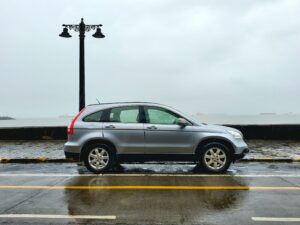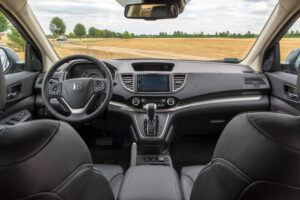What is the Best Year for a Honda CR-V?
The Compact Recreational Vehicle, or CRV, is Honda’s term for what most know as a crossover SUV. They’re the perfect size for consumers seeking to have more space while being lighter and smaller than a standard SUV.
Now in its fifth generation, the Honda CR-V was introduced to America by the Japanese automaker in 1996 at the Chicago Auto Show. Its main competitors are the Hyundai Tuscon and the Toyota RAV4.
If you’re buying a used car that is 10 years old or newer and under 225,000 kilometers, get a free quote in seconds, 100% online for Mechanical Breakdown Coverage. No robocalls and plans for every budget!
GET A FREE QUOTE FOR COVERAGE
The Honda CR-V is ranked 2nd out of 26 other vehicles in the category of compact SUVs, scoring a 4.5 out of 5 in reliability with a bonus of being economical to own.
What Are Common Honda CR-V problems?
While reliability is high, if you are considering a Honda CR-V there are two model years we must caution you about. Many owners of the 2015 model complained that the vehicle violently shook while in idle. Honda responded to this complaint with a service bulletin suggesting owners replace the transmission mount of the powertrain control module. While these fixes worked for some, others still continue to have this problem.
However, as bad as a shaking car may be, the 2011 model received unfortunate notoriety as the recipient of CarComplaints’ “Beware of the Clunker” Award. The list of problems with the 2011 CR-V is shorter than other years, but they should really change the name of it to the 2011 CVS because the receipt of fixing them is much longer.
While the clutch and air conditioner compressors had their own list of problems, many complained of steering fluid leaks and premature tire wear. But if safety is of the utmost importance to you, the National Highway Traffic Safety Administration (NHTSA) got wind of an airbag inflation problem after a multitude of complaints, four years earlier than the notorious #deflategate. Reminder to check your tire pressure even before the light on your dashboard reminds you to. This can prevent unnecessary tire wear.
Honda CR-V Problems by the Year

2002 ushered in the second generation of Honda CR-Vs, which unveiled the new 2.4L engine and new safety features. However, while these new features were exciting and arguably necessary, they led to higher repair costs, even in minor collisions. Honda was not able to solve the problems with the rear differential with this release and regular maintenance is still a necessity. U-joints, motor mounts, and oxygen sensors were also reported to fail.
The most problematic years of the second generation Honda CR-V fall between 2002-2006, the years of the grimly named “Black Death.” This is when the air conditioning compressor self-destructs, forcing microscopic metal shavings to mix with the lubricating oil, clogging the system’s passageways. It’s impossible to clean out completely and the only permanent fix is to rebuild the entire AC system, a very costly repair.
The third generation Honda CR-Vs were between model years 2007-2011, and some
The 2010 and 2011 model years had faulty piston rings, leading to leaks and high consumption of oil. Luckily for owners, Honda did extend the warranty on those parts to eight years or 200,000 kilometers.
2010 CR-V models also faced airbag recalls, problems with the electrical systems, and malfunctioning transmission control modules.
The Honda CR-V’s fourth generation spans 2012 – 2016 model years. It’s worth noting that CarComplaints deems this generation as the one with the most complaints. Leading the way with aggressive shaking while idle is the 2015 model. Additionally, the seating was uncomfortable, many complained of issues with the heater, and the soy wiring was a favorite among rodents.
Generation five covers model years 2017 to present and is the least problematic out of all CR-V generations, but it’s not without its faults. Between the fourth and fifth generations, Honda did not change the sustainable soy wiring and rodents chewing through the wire were still an issue for several owners. Fuel vapors seeped into the turbo engine, creating a very costly problem for owners.
Additionally, the cruise-control was known for getting “confused,” the heating system had several complaints raised such as; little to no heat production while the car was idling and oil overflow. These issues led to drivers reporting concerns with the car’s fuel injection system and a gas odor inside the car.
Know Your Honda CR-V
Here is a crash course for Honda CR-V owners to understand the reported issues, terminology, and other important info:
Honda CR-V Starter Issues
If the starter is failing, a weak battery is the likely culprit. Other possibilities include a failed starter or a faulty alternator.
Honda CR-V Intermittent Starting Issues
The top causes of starting problems are due to faulty electrical systems, immobilizer errors, key fobs needing a new battery, battery terminal corrosion, a clogged up fuel filter, and no gas in the tank.
Honda CR-V Power Tailgate Issues
This problem is commonly a result of a broken tailgate motor. A faulty sensor may also prevent the tailgate from closing or opening when pushing the button.
Honda CR-V AC and Air Compressor Issues
Faulty AC systems are seen mostly in model years 2015 – 2019. Cracks in the condenser caused refrigerant to leak, meaning the system could no longer blow cold air. As the refrigerant leaks, other vehicle components become susceptible to damage.
Honda CR-V Shutter Grille Problem
The Honda CR-V’s grill shutters must work in synchronicity for optimum fuel efficiency, controlling the airflow to increase fuel efficiency by reducing aerodynamic drag. If the upper shutter and lower shutter aren’t communicating, the powertrain control module reduces its power.
Honda CR-V Oxygen Sensor Problem
If the oxygen sensor fails, it could lead to stalling, rough idling, misfires, and a decreased fuel efficiency. It may also result in a failed emissions test.
Honda CR-V Catalytic Converter Problems
Though they can wear out over time, a catalytic converter failure isn’t common and is generally the result of something else being compromised. Some telltale signs of a catalytic converter problem include: a rattling sound in the engine, an unusual smell coming from the exhaust, hearing misfires, acceleration jerks, losing engine power, black smoke, and/or a reduction in gas mileage. If it is your catalytic converter, your check engine light should typically be on. The EPA’s Federal Emissions Warranty states that they must be covered for 130,000 kilometers or eight years, whichever comes first.
A heater issue in a Honda CR-V could be the result of many complications, but common causes are low coolant levels or a broken thermostat. If it’s not a simple fix, it could be a problem with the heater core.
Honda CR-V Blind Spot Info System Problem
If you see a “blind spot info system problem” warning on your dashboard, it is most likely due to a faulty sensor.
Honda CR-V Collision Mitigation System Problem
This driver assistance tech was designed to assist in lane assistance, collision avoidance, adaptive cruise control and road department mitigation, while a radar-based system keeps your car at a consistent distance away from the traffic ahead of you. This technology has experienced problems, which in turn resulted in lawsuits. If the collision mitigation system senses a potential obstacle ahead that may result in a collision, it will brake the car to avoid crashing.
Honda CR-V Bluetooth Issues
Many Honda CR-V Bluetooth problems have a simple fix. If your phone isn’t connecting or the Bluetooth isn’t working, you can remove the CR-V’s Bluetooth from your phone’s memory, as well as the Bluetooth entry from the car. Restart your phone and turn your car off, then back on and try pairing them again.
Honda CR-V Engine Problems
The Honda CR-V “check engine light” is what nightmares are made of for several owners. There is truly nothing worse to occur than picking your vehicle up from the repair shop, only to have the “check engine light” pop back up on the dashboard less than a week later.
If you see the “check engine light” warning on your dashboard, here are a few things you should pay attention to and notify your mechanic about if present:
- While driving, can you smell gasoline?
- Does the smell also occur outside of the vehicle?
- Is your car losing power?
- Has your car been stalling?
- Is there a delayed acceleration?
- Are you going through CR-V batteries more often than you should?
There are many reasons why a check engine light may glow, but take note of anything out of the ordinary that happens when you see it appear.
Honda CR-V Engine Replacement Cost
A new CR-V engine costs upwards of $5,000 (or more), while a remanufactured engine is typically around $3,100.
Honda CR-V Brake System Problem
Sometimes when the brake system warning light is triggered, it means that brake fluid could be low. Be sure to check your levels if you see this message. If nothing is wrong with the fluid levels, it could be due to a dying car battery. When your engine starts, many dashboard lights will go on and off when juice is low. If fluid levels look good and your battery is fully charged, seek professional help.
Electric Parking Brake Problem Honda CR-V
Do Honda CR-Vs Have Transmission Problems?
If you are experiencing troubles shifting in manual transmission models, the most likely cause is low transmission fluid. As parts are not getting lubricated, there will be areas of high friction, leading to overheating and damage. There are several warning signals to look out for if you suspect your transmission is in trouble:
- The smell of something burning
- Gears slipping
- Fluid leaks
- Shaking and/or grinding
- Difficulty shifting gears
- Unusual engine noise
These manual transmission issues were more common in 1997 – 2000 Honda CR-V models.
Honda CR-V Automatic Transmission Issues
Technical Service Bulletins (TSBs) have addressed acceleration and “harsh shifting” problems, along with vibration and noise. 237,000 Honda CR-Vs model years 2002 and 2003 were recalled due to transmission problems. The shift cable linkage has the tendency to deteriorate, prohibiting drivers from shifting into park. Even with these occurrences, the Honda CR-V remains a reliable car with very minimal transmission issues.
Honda CR-V Transmission Replacement Cost
Transmissions are expensive to replace and Honda CR-Vs are no exception to this. A replacement typically costs $4,500. For this reason, it is worth it to have regular transmission maintenance done on your vehicle, including transmission flushing and fluid changes. According to Honda maintenance schedules, it is recommended to have CR-V transmission fluid changed every 145,000 kilometers. Please refer to your owner’s manual for specific information related to your CR-V.
Honda CR-V Electric Window Problems
We all know that liquids and electricity don’t mix well, which was true to be the case for Honda’s recall of 260,000 CR-Vs, model years 2002-2006. The power window switch failed when it came into contact with moisture, commonly due to rain coming in through an open window or liquids spilled on the driver’s side door. If this happens to you, seek maintenance help to fix it.
Honda CR-V ABS Problems
A Honda CR-V ABS (anti locking brake system) pump module failure was a common issue for model years 2002-2008. When this failure occurred, the VSA/ABS light would come on.
Honda CR-V Head Gasket Problems
A head gasket problem will commonly present itself in the form of white smoke emitting from the tailpipe, coolant loss minus signs of leakage, a bubbling sound coming from the radiator, an overheated engine, and/or engine oil with a slight milky color.
While head gaskets are inexpensive themselves, the installation labor comes with a hefty price tag. Expect to pay at least $1,500 on the repair.
A way to mitigate this future expense is to replace coolant approximately every 95,000 kilometers and your air filter every 25,000 to 50,000 kilometers. Every 160,000 kilometers, be sure to check your spark plugs (sooner if they’re copper, about 50,000 kilometers). As long as your engine is running smoothly and not overheating, your head gasket should remain in great condition. That means with a Honda CR-V, you should be going strong for 10+ years or 320,000+ kilometers
Honda CR-V Ignition Problems

Honda CR-V Strut Problems
If your CR-V model year is 1996, this one applies to you as that particular year was riddled with suspension problems. The top complaints stemmed from issues with the front suspension as well as its control arm.
Honda CR-V Door Lock Problems
Between model years 2007-2011, many faulty door lock actuators were reported. Even after the problem was fixed, many owners reported continued failures, resulting in a lawsuit where Honda ultimately extended the warranty on the faulty part.
Honda CR-V Oil Problems
In model years 2017-2018, the CR-V with a 1.5-liter turbo engine had an oil dissolution problem. If you smell raw fuel inside the vehicle while driving, this could indicate that gasoline is leaking into the engine and it will need to be fixed before resulting in catastrophic engine failure.
Emissions System Problems Honda CR-V 2018
An air mass flow sensor may be the culprit of an illuminated emission system light, especially if you have a 2018 Honda CR-V.
Honda CR-V Compass Calibration Problems
For this particular problem, we recommend checking your owner’s manual. If that fix isn’t working, please refer to the CR-V owners club online chat group.
Honda CR-V Fuel System Issues
In a recent recall, 2018-2019 Honda CR-Vs had a fuel pump issue that could potentially lead to an engine stall while the vehicle was in motion. Owners of these models can determine if their vehicles are involved by keying in their vehicle identification number at www.recalls.honda.com. If included, Honda will replace the fuel pump assembly.
Honda CR-V Motor Mount
If this component fails, you’ll generally be able to tell by the cabin vibration experienced while driving. The mount can be replaced and generally costs around $760.
Honda CR-V Sudden Acceleration
A big legal problem for Honda ensued as the 2011 CR-V had reports of acceleration, even when the brake was being pressed.
Honda CR-V Adaptive Cruise Control Problem
Honda CR-V owners can calibrate their “sensing” to meet their driving preferences. Here’s a “how-to” from MajorWorld.
www.majorworld.com/can-you-turn-honda-sensing-off/
Honda CR-V Alternator Problems
If the alternator light comes on, do not ignore it! You will soon lose power – yes, even while driving. The cabin lights will start to dim and the engine will eventually stall. A pair of jumper cables won’t help you here – you’ll need to replace the alternator, which runs between $760 and $1,400.
What Are The Average Maintenance Costs for Honda CR-V?
The good news is that the Honda CR-V is significantly cheaper to maintain than similar vehicles in its class. The reliability of this vehicle is incredible, especially if you take care of it with regular maintenance. According to RepairPal.com, the average annual maintenance cost of the Honda CR-V is $547.
How Much is a Honda CR-V?
According to Motor1, the next generation Honda CR-V is rumored to debut summer 2022 with the 2023 model year. The estimated starting price for this model is $35,000. For comparison, the 2022 Honda CR-V starts at $34,200 for the base LX model and up to $46,700 (starting) for the highest trim model, the Touring edition.
Additional trims include the CR-V Special Edition ($35,200 starting MSRP), the CR-V EX ($36,900), the CR-V EX-L ($40,200). The cost for a fully loaded CR-V can exceed $50,000.
How Much is a Honda CR-V Hybrid?
If you’re interested in the hybrid CR-V, the lowest trim available is the Honda CR-V Hybrid EX, starting at $40,800. Additional trims include the Honda CR-V Hybrid EX-L ($44,100) and the Honda CR-V Hybrid Touring ($48,200).
The 2022 Honda CR-V Hybrid was given a 3/5 by Kelley Blue Book and a 8.2/10 by US News & World Report. It gets an impressive 5.88 L/100 km city and 7.84 L/100 km highway.
What is The Best Year for a Honda CR-V?
Many people still get a lot of mileage out of their older model Honda CR-Vs, which are arguably as reliable as some of the newer model years. If you’re looking for an older model with good fuel reliability, a reliable engine and a comfortable ride, check out model years 2005 and 2006.
If you’d prefer a new model that can still qualify for mechanical breakdown coverage, the 2015 and 2016 models are a great option due to the Continuously Variable Transmission giving the all-wheel-drive an average of 9.047 L/100 km in the city. These CR-V model years are reliable, with great handling and a larger interior space.
Summary
Honda makes up one of Canada’s top three car brands sold in the country. The Honda CR-V came in at #6 on driving.ca’s list of Canada’s 10 Best-Selling Vehicles of 2021. It’s even built in Canada at Honda’s two assembly plants in Alliston, Ontario.
The Honda CR-V has a great safety reputation, handles well, and is an affordable option for a crossover SUV. Additionally, Consumer Reports gives the Honda CR-V 4 out of 5 points for customer satisfaction.




